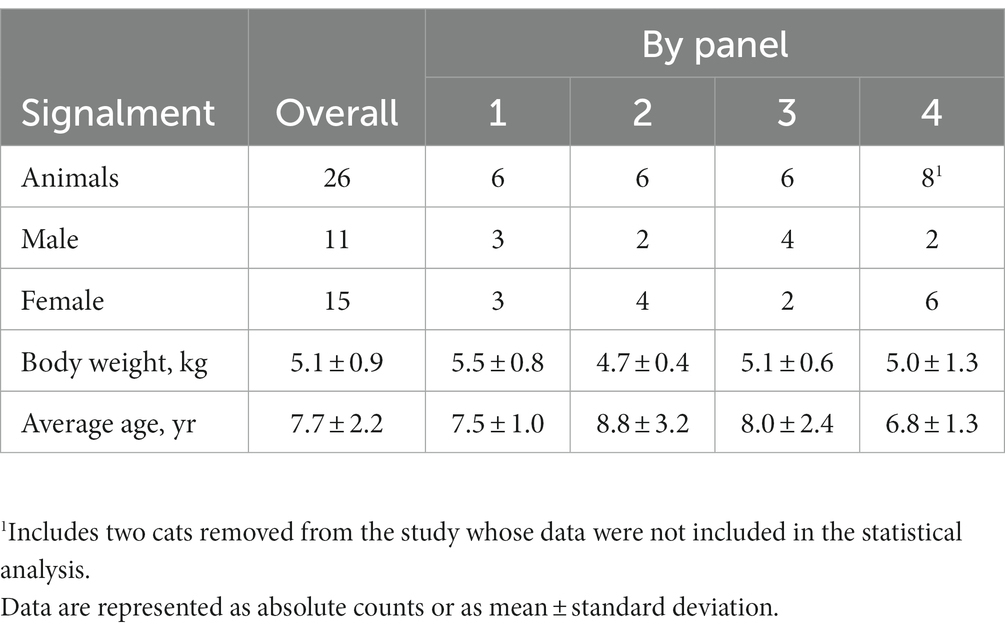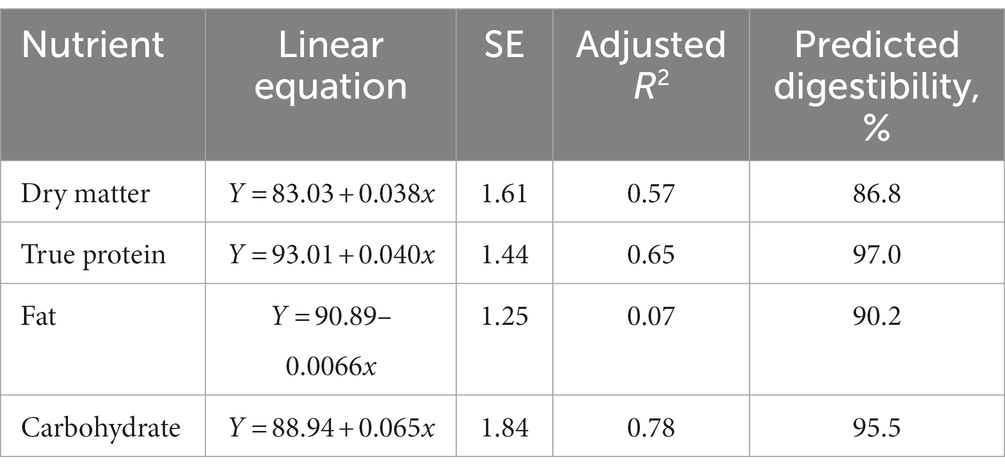- 1Hill’s Pet Nutrition, Inc., Topeka, KS, United States
- 2Department of Animal Science & Industry Adjunct Faculty, Kansas State University, Manhattan, KS, United States
Introduction: The use of rice protein concentrate (RPC) as a protein source in cat food is uncommon. Therefore, this study aimed to determine the acceptability and digestibility of foods formulated to contain increasing levels of RPC to support its inclusion in foods for adult (non-gravid, non-lactating) cats.
Methods: Increasing levels of RPC (0, 7, 14, and 28%) were formulated into test foods fed to 24 cats in a Latin square design with 15-day periods and no washout between periods. Food intake and fecal scores were measured to determine the acceptability of test foods. Fecal output was measured on days 11–15. Food and fecal samples from day 15 of each period were analyzed for nutrient composition to calculate the macronutrient digestibility of the test foods. Analysis of variance and orthogonal contrasts were used to assess the effects of RPC inclusion on food intake, fecal output, fecal scores, and macronutrient digestibility.
Results: The results showed that as-fed (AF), dry matter (DM), and gross energy (GE) intake increased with increasing RPC levels (p > 0.05). Fecal output, both as-is and DM, was unaffected by RPC inclusion (p > 0.05); however, fecal scores increased linearly with increasing RPC inclusion (p < 0.001). Furthermore, true protein and apparent DM, GE, and carbohydrate (NFE) digestibility increased linearly with RPC inclusion (p < 0.05). Apparent fat digestibility was high for all test foods but was unaffected by RPC inclusion (p = 0.690).
Discussion: Overall, the inclusion of RPC was well-accepted, improved fecal characteristics, and increased the apparent and true macronutrient digestibility compared to the control. Therefore, this study demonstrated that RPC can serve as a high-quality and acceptable protein source for adult cats.
1. Introduction
A consistent supply of good quality protein with uniform amino acid content is required to formulate high-quality foods designed to meet the nutritional needs of cats. To this end, sources of plant proteins, such as corn gluten meal, wheat gluten, pea protein, and potato protein, are already widely used and accepted in commercial cat foods (1). The inclusion of plant proteins in food can reduce the requirement for animal protein sources and may have a less negative impact on the environment (2).
From a clinical standpoint, cats with food intolerances, gastritis, enteritis, or other chronic conditions need a source of protein that is palatable, maximally digestible, and that they can tolerate (3). As a result, therapeutic foods for these indications often utilize alternative or hydrolyzed protein sources to reduce the likelihood of adverse food reactions (4–6). Since the digestibility of plant proteins has been observed to be comparable to that of animal proteins in feline foods (1), it is worth investigating the inclusion of concentrated plant proteins such as rice protein concentrate (RPC) in feline foods formulated for these conditions.
Rice protein concentrate is sourced from rice or rice brokens, which are co-products of milling husked rice to produce white rice. To prepare RPC, rice is first soaked in water and then ground; protein is then solubilized and insoluble starch is decanted. The protein is then recovered by precipitation and dried to form a concentrated protein powder (7). The resulting RPC is a high-quality protein source that provides an amino acid (AA) content comparable to that of other commonly used protein sources in pet foods (7, 8). Hydrolyzed rice protein and rice protein concentrate have been investigated and are currently used as alternatives to cow’s milk or soy protein in infant formulas. They are considered to be safe, viable alternatives for infants with cow’s milk protein allergy (9–11). Rice protein concentrate has also been evaluated as a protein source in the diets of weaned pigs and farmed fish, like rainbow trout and sea bass. These investigations report that RPC could be used as a replacement for other protein sources, such as dried whey and fish meal, without adverse effects on health or growth performance (12–16). These studies also highlighted an important limitation of RPC as a protein source, which is that it may be lacking in some essential amino acids, such as lysine, thus emphasizing the importance of including other protein or amino acid sources as needed to ensure that amino acid requirements are met.
However, information regarding the use of RPC in feline foods is limited. Although the digestibility of cat and dog foods containing RPC and other plant-based proteins has been investigated (1), the effects of increasing RPC levels on acceptability and digestibility in cats are unknown. This study aimed to determine the acceptability, metabolizable energy, and macronutrient digestibility of feline foods containing increasing levels of RPC. The digestibility of macronutrients in the RPC ingredient itself was estimated using regression analyses. It was hypothesized that the inclusion of RPC would not negatively affect the acceptability or macronutrient digestibility of the test foods.
2. Materials and methods
2.1. Humane consideration
This study was conducted with the approval of Hill’s Pet Nutrition Institutional Animal Care and Use Committee (IACUC) and in accordance with Hill’s Global Animal Welfare Policy. At no time was any animal subjected to procedures expected to cause pain or distress.
2.2. Animals
Cats of at least 1 year of age, fully grown, in good health, and with a known weight were considered for inclusion in this study. Cats were excluded from the study if they had been diagnosed with a chronic disease, including, but not limited to, kidney disease, cancer, hyperthyroidism, and diabetes. Cats enrolled in the study were subsequently removed from the study if they: (1) experienced excessive weight loss (>1.5% per week); (2) stopped eating for 2 days or ate less than 50% of the food offered for 3 days; or (3) were subsequently diagnosed with any secondary systemic disease as described in the ‘exclusion criteria’ mentioned above. All cats were immunized against Rabies (rabies), Felid alphaherpesvirus 1 (viral rhinotracheitis), Feline caliciviridae (feline calicivirus), and Feline panleukopenia (feline panleukopena virus). None of the cats had chronic systemic disease, as evaluated by annual urinalysis, serum biochemical analyses, complete blood count, and physical examination. The cats were housed individually, owned and maintained by Hill’s Global Pet Nutrition Center, and treated in accordance with Hill’s Global Animal Welfare Policy. While individually housed, the cats had access to group socialization and interaction with animal care technicians and toys. The study design did not interfere with the daily routines of the animals. The cats were housed in temperature-controlled facilities with access to natural light.
Twenty-six domestic shorthair cats (15 spayed females, 11 neutered males; 5.1 ± 0.9 kg body weight; 7.7 ± 2.2 years of age) were initially enrolled in this study, and a summary of their signalment is shown in Table 1. Two cats were removed from the study: one was removed because of a health concern that required an antibiotic regimen (deemed by the attending veterinarian to be unrelated to the test food), and the cat selected to replace the first cat was subsequently removed from the study after poor eating as outlined above. Thus, a total of 24 cats completed the study and were included in the statistical analysis. Following enrollment, the cats were fed once daily to maintain their ideal body weight based on the daily metabolizable energy requirements of adult cats at maintenance, calculated as (70 × BW0.75) × 1.2, and the food intake was manually recorded each day by an animal care technician. Water was provided ad libitum.
2.3. Study design
This study used the American Association of Feed Control Officials (AAFCO) quantitative collection protocol (17) with a minimum of six adult cats. This protocol consists of two phases. The pre-collection phase lasts for at least 5 days and allows the cats to become acclimated to the test food. Food intake is then adjusted as needed to ensure that weight is neither gained nor lost. The next five-day phase is used for total fecal collection. Food offerings remain unchanged during the fecal collection phase (based on the amount needed to maintain weight from the earlier phase).
In this study, 24 adult male and female cats were grouped into four panels (n = 6 cats per panel) that were arranged in a 4 × 4 Latin square design. Each panel was fed each test food for 15 days with no washout between periods. Body weight (BW) was measured on days 1, 8, and 15 during each period. Fecal scores were recorded on days 10–15 using a 6-point scale (1 = liquid diarrhea, 2 = soft feces lacking form, 3 = soft, moist, but formed feces, 4 = firm, well-formed feces, 5 = hard, segmented feces, and 6 = constipation with no feces). Fecal scores of 3–5 were considered normal. Feces were collected from each cat individually using non-absorbent beads (Providence House Manufacturing, Inc., Seal Rock, OR, USA) in a litterbox and were weighed on days 11–15. Cats were individually fed once daily with access to food for approximately 22 h each day, and their food intake was recorded. Food and fecal samples from day 15 were analyzed for nutrient composition and subsequent calculation of digestibility.
2.4. Study foods
The study foods were manufactured using a Wenger X-115 extruder (Wenger Manufacturing, Inc.; Sabetha, KS, USA) according to the manufacturing procedures outlined in Supplementary Table 1. Test foods were formulated to meet or exceed AAFCO requirements for adult cats at maintenance, with the major ingredients and nutrient profiles of the study foods are summarized in Tables 2, 3, respectively. The analyzed nutritional composition of the RPC included in the test foods on a dry matter basis (DMB) is provided in Supplementary Table 2 and compared to grade A whole large eggs (18) as an indicator of protein quality.
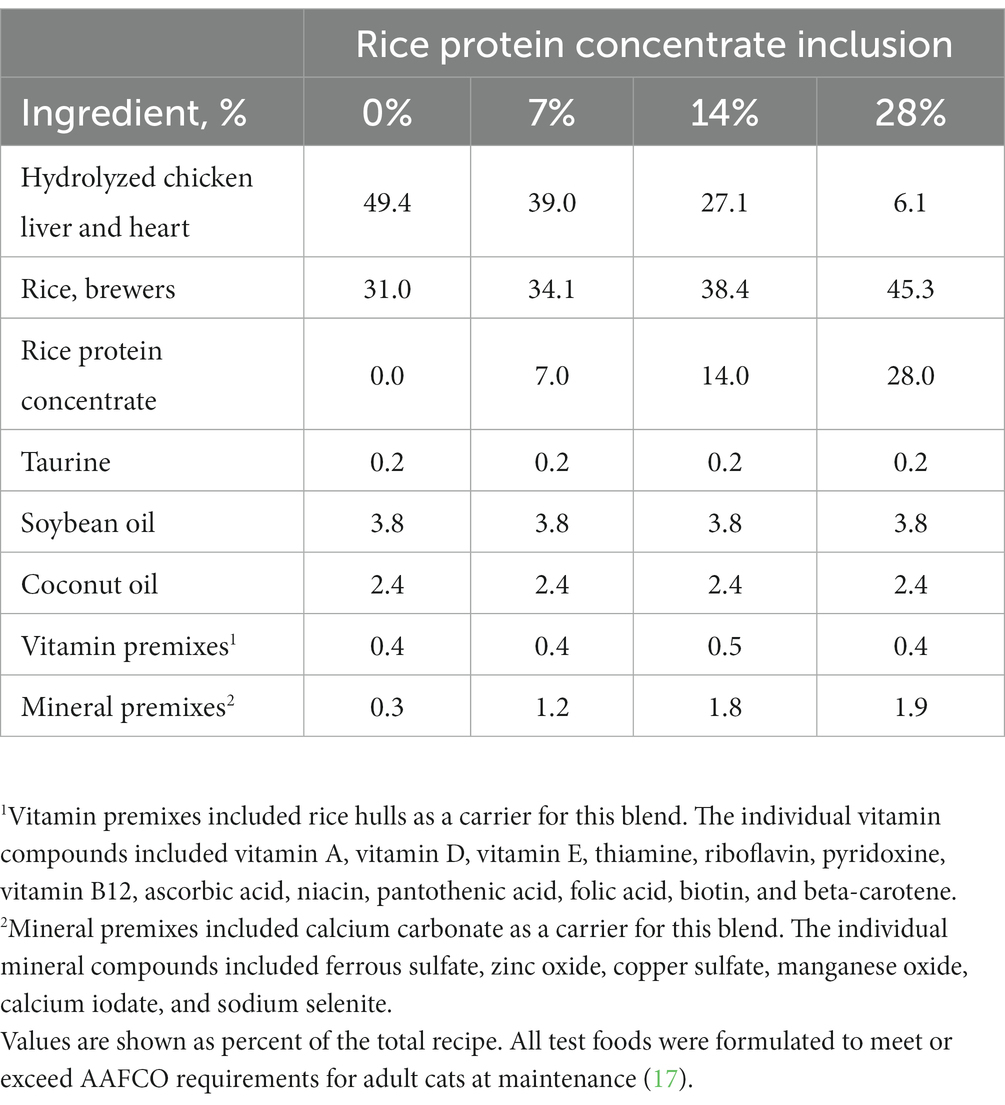
Table 2. Select ingredients included in test foods containing increasing levels of rice protein concentrate.
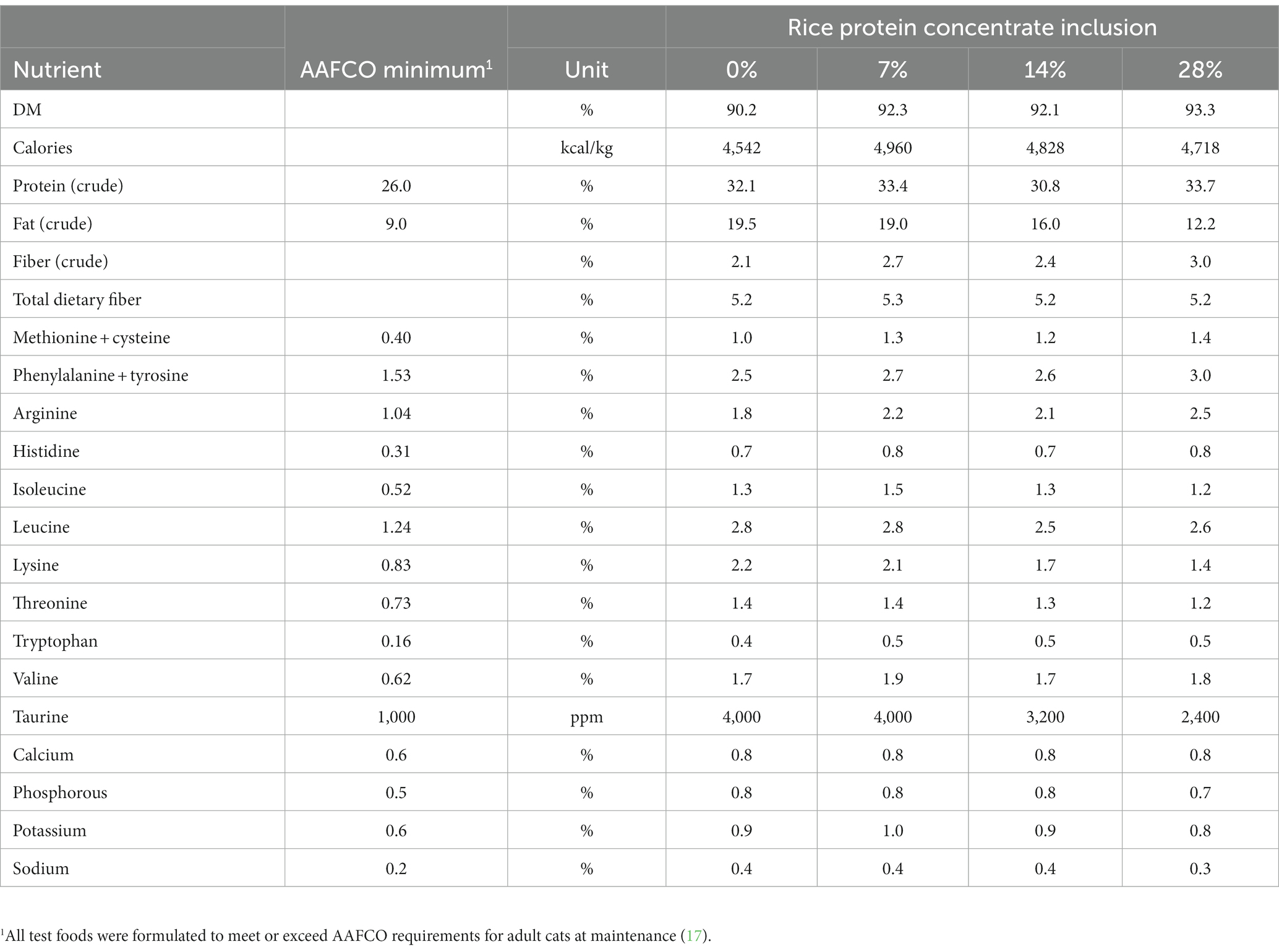
Table 3. Analyzed nutrient composition and energy content of test foods containing increasing levels of rice protein concentrate (RPC) on a dry matter basis.
2.5. Sample analysis
Measurements of ash, crude fiber, fat, protein, moisture, dry matter, and gross energy were completed for both food and fecal samples by a commercial laboratory (Eurofins Scientific, Inc., Des Moines, IA, USA) using official methods of analysis published by AOAC International (19).
The apparent digestibility of dry matter (DM), fat, gross energy (GE), and carbohydrates (nitrogen-free extract or NFE) was calculated as follows:
To correct for endogenous metabolic fecal protein (i.e., fecal protein of non-dietary origin), an endogenous protein correction of 63 mg nitrogen/kg weight to the ¾ power suggested by Kendall et al. was used (20). This value is in the range of estimates for fecal metabolic protein for both the dog and cat (21, 22). Therefore, true protein digestibility was calculated by subtracting an estimate of the metabolic protein contained in the feces from the measured fecal protein concentration. This was calculated as follows:
2.6. Statistical analysis
An investigation revealed an error in the fat analysis of the 28% RPC food sample collected during the first period of the study (3.1% crude fat compared to the mean of 12.2% crude fat from the three samples of the 28% RPC food collected during the other three periods of the study). This resulted in an artificial reduction in the subsequent calculation of apparent fat digestibility for that period. The error could not be rectified because the sample had already been destroyed. Therefore, data regarding fecal fat content from the first period for the panel consuming 28% RPC were removed from the analysis and were not included in the apparent fat digestibility calculations, as they were >3 standard deviations from the mean. All remaining data were analyzed using analysis of variance (ANOVA) of a linear model in R (v. 4.0.3) (23), including the fixed effects of diet, period, panel, and all associated interactions. The fixed effect panel was not significantly different (p > 0.05) and was removed from the model along with all associated interactions. Orthogonal contrasts were used to determine the linear, quadratic, or cubic relationships. The macronutrient digestibility of 100% RPC was predicted using linear regression analysis. The effects were considered significant when p ≤ 0.05. The results were presented as mean ± standard deviation or standard error, as appropriate.
3. Results
3.1. Food intake and fecal characteristics
The mean food intake and fecal characteristics are presented in Table 4. Neither the period nor the interaction of treatment by period affected body weight, food intake or fecal characteristics (p > 0.05). Mean food offered (63.4 ± 5.1 g as-fed/d) and BW (5.1 ± 0.3 kg) were similar between treatments (p = 0.278 and 0.365, respectively). As-fed (AF), DM, and GE intakes increased with RPC inclusion compared to control (p = 0.040, 0.017, and 0.040, respectively) but were similar between RPC inclusion levels (p = 0.880, 0.957, and 0.879, respectively). Fecal output, both as-is and DM, was unaffected by the inclusion of RPC (p = 0.267 and 0.685, respectively). With increasing RPC inclusion, fecal moisture decreased linearly (p = 0.001), whereas fecal scores increased linearly (p < 0.001). However, all mean fecal scores were considered normal for all treatments.
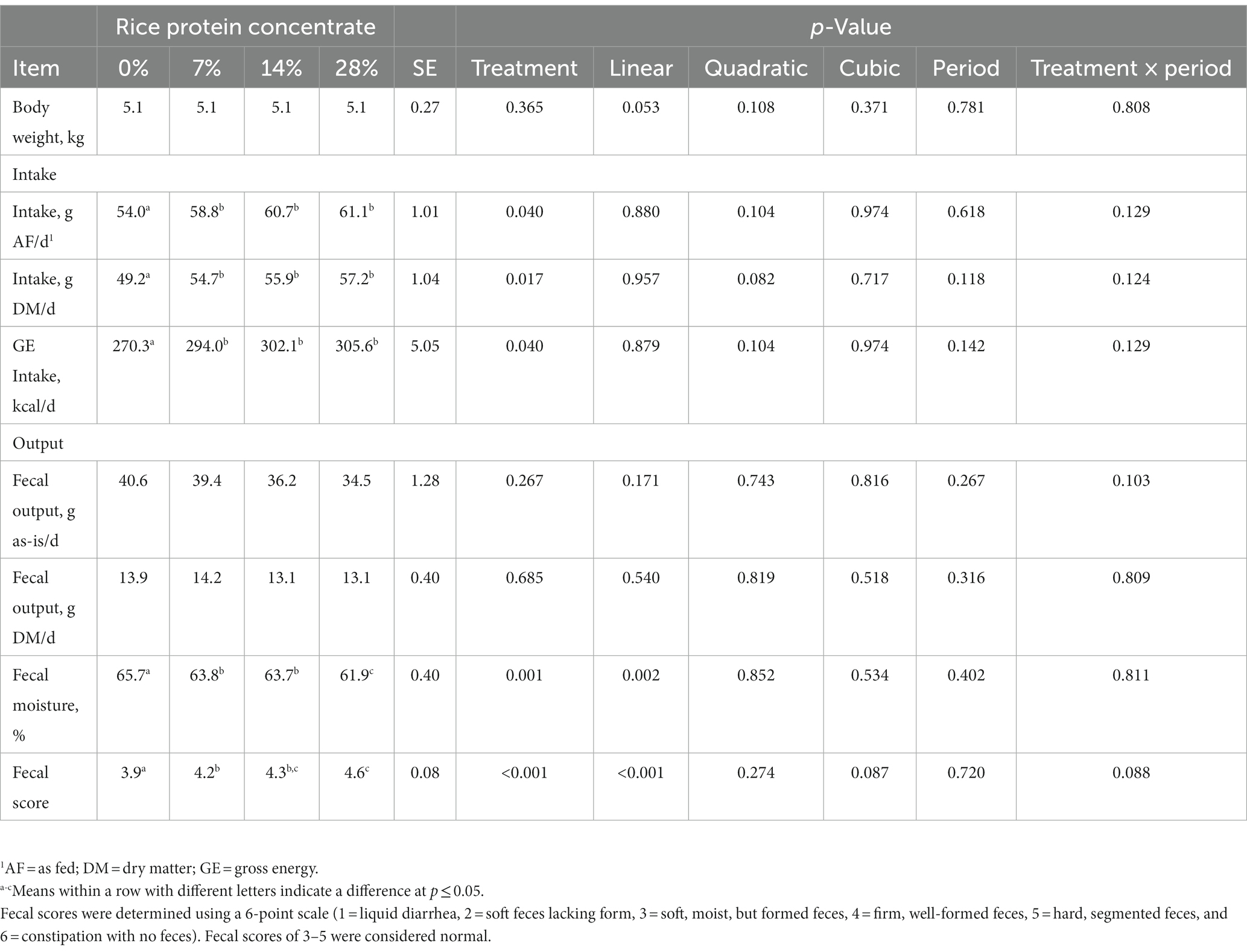
Table 4. Mean intake, fecal output, and fecal scores of cats consuming increasing levels of rice protein concentrate.
3.2. Macronutrient digestibility
The apparent macronutrient digestibility and true protein digestibility of test foods with increasing levels of RPC are presented in Table 5. Neither the period nor the interaction of treatment by period affected digestibility of any macronutrients (p > 0.05). Except for apparent fat digestibility (p = 0.690), the digestibility of all macronutrients increased linearly with increasing RPC inclusion (p < 0.05).
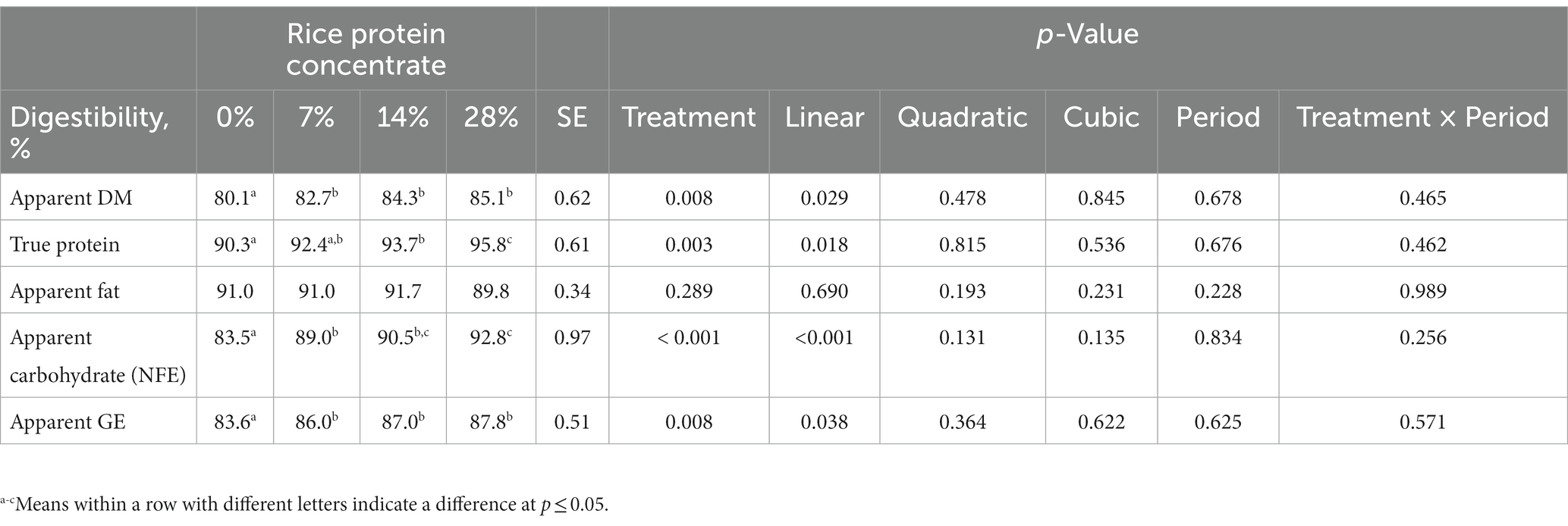
Table 5. Total tract apparent and true macronutrient digestibility in cats consuming increasing levels of rice protein concentrate.
3.3. Predictions of digestibility of RPC
The test food recipes were designed with increasing levels of RPC (0, 7, 14, and 28%), with adjustments to the amount of hydrolyzed chicken liver and heart, and rice in the recipe to create test foods with similar levels of total protein. This allowed a prediction to be made regarding the apparent macronutrient digestibility of 100% RPC (Table 6). The predicted value in adult cats was high, with predicted dry matter digestibility above 85%, predicted fat digestibility above 90%, and predicted protein and NFE digestibility above 95%. Since there was no effect of RPC on apparent fat digestibility, the R2 for predicted apparent fat digestibility was low (R2 = 0.07), indicating it is a poor model for estimating the apparent fat digestibility of 100% RPC.
4. Discussion
4.1. Characteristics of RPC
Rice protein concentrate can be considered a high-quality protein source because it is an excellent source of essential AAs. Compared to Grade A large whole eggs, which may be considered the gold standard in protein quality and digestibility for both human and pet nutrition (8, 24), the nutritional composition of the RPC used in this study meets or exceeds the DM AA content of whole eggs in all but two AAs: lysine and cysteine (10). It is common for plant-based proteins to be deficient in at least one essential amino acid (8, 25), further emphasizing the importance of ensuring that foods utilizing plant proteins such as RPC are formulated to be complete and balanced, which has been recommended when other plant protein sources have been investigated for use in companion animal foods (25). For example, all four test foods in this study were supplemented with taurine at the same level (0.2% of the recipe), but inclusion of brewers rice and RPC in test foods (at the expense of hydrolyzed chicken liver and heart) reduced the taurine content of the 14 and 28% foods as neither brewers rice nor RPC contains no taurine. However, all AA levels in these test foods, including taurine, exceeded the minimum recommended allowance of the National Research Council (26) and the AAFCO minimum (17) for adult cats at maintenance as a result of the supplemental taurine added to the test foods.
4.2. Food intake and fecal characteristics
Overall, the study foods were well-accepted by all cats. While the amount of food offered was similar between treatments, AF and DM intakes increased with RPC inclusion compared with those in the control food, which resulted in greater gross energy intake when cats were fed RPC-inclusive foods. Since cats were fed to maintain their ideal body weight, this may indicate a preference for foods with higher levels of RPC, which may be of particular interest because cats are often picky eaters (27). However, the increased energy intake did not translate into an increase in BW. This was most likely a result of the short experimental period (15 d). A similar effect was reported by Detweiler et al. (28), who reported lower food intake but no change in BW when cats were fed an experimental food formulated with beet pulp as the main source of dietary fiber. One notable limitation of the current study is that neither body condition score nor muscle condition score were assessed. It would be prudent in future work to include such measures in addition to BW in order to assess the potential of RPC to affect lean body mass or fat mass. The increase in intake also did not translate into an effect on fecal output (for as-is or DM). These data were consistent with the increase in DM digestibility with increasing RPC inclusion in the test foods. The fecal scores, while considered normal (stool scores of 3–5 on a 1–6 scale) for all test foods throughout the study, increased linearly with increasing RPC inclusion, which is consistent with the corresponding decrease in fecal moisture. The increased fecal score was likely due to high digestibility, reduced hydrolysate content, and slightly higher crude fiber content in the recipes containing RPC. While an increase in dietary fiber is associated with increased fecal output (29–31), it is likely that the fiber differences in these test foods were not substantial enough to impact as-is fecal output as seen in these other studies.
4.3. Macronutrient digestibility
All study foods were highly digestible, with the digestibility of all macronutrients above 80%. Except for apparent fat, the digestibility of all macronutrients increased linearly with increasing RPC inclusion. Apparent fat digestibility was high (>90%) in all test foods and was unaffected by RPC inclusion level, though this may be a result of the error in food sample analysis that resulted in the removal of one 28% RPC period’s apparent fat digestibility data. This can be avoided in future work through the closer inspection of results and retention of samples to re-analyze if necessary. While the predictive equation for apparent fat should not be used due to the absence of an effect of RPC on apparent fat digestibility as well as the poor fit of the linear regression predictive equation for fat digestibility, the predicted macronutrient digestibility of 100% RPC was high for all other macronutrients (above 85% for DM and above 95% for both protein and carbohydrate). The hydrolyzed chicken ingredient was specifically chosen as the other primary protein source because hydrolyzed meat ingredients are considered highly digestible protein sources and are commonly used in foods for cats with food sensitivities as proteins with lower molecular weight (< 10,000 daltons) are less likely to elicit an immune response (32). Thus, it is interesting that replacing the hydrolyzed chicken ingredient with RPC resulted in higher protein digestibility. However, all test foods, including the control that had the hydrolyzed chicken ingredient as the primary protein source, demonstrated true protein digestibility above 90%. These results do not indicate that hydrolyzed meat ingredients are poorly digestible, but rather that molecular weight of an ingredient is not the only factor determining the digestibility of a protein source. These data are consistent with previous investigations on the digestibility of plant and animal proteins in feline foods, in which protein digestibility in cats increased with the percentage of dietary protein from plant-based sources (1). As with AA content of the ingredient, RPC may also be comparable to whole eggs in terms of protein digestibility. Previous work has shown that when used in dog food at 20% of total crude protein, an egg-inclusive food had a total tract apparent protein digestibility of 91.2% (33).
In conclusion, adult cats were fed foods containing increasing levels of RPC up to 28% of the total recipe, and it was demonstrated that RPC could serve as a protein source in cat foods owing to its high digestibility and protein quality. Overall, the inclusion of RPC was well-accepted by cats, improved fecal characteristics, and increased the apparent and true macronutrient digestibility compared with the control food that did not contain RPC. Thus, RPC may serve as a complementary protein source in feline foods considering its AA content, good digestibility, and excellent taste acceptance, all of which make it appropriate for use in therapeutic foods indicated for cats with food sensitivities. Future directions include the investigation on the effect of RPC inclusion on lean body mass in cats.
Data availability statement
The raw data supporting the conclusions of this article will be made available by the authors, without undue reservation.
Ethics statement
The animal study was reviewed and approved by Hill’s Pet Nutrition Institutional Animal Care and Use Committee.
Author contributions
KG and SP: conceptualization. KG, SP, and CS: methodology, writing—review and editing. EM: formal analysis, project administration, and writing—original draft preparation. KG and CS: investigation. EM and KG: data curation. KG: supervision. All authors contributed to the article and approved the submitted version.
Funding
The study was funded by Hill’s Pet Nutrition, Inc. The funder employed or funded the active participation of all authors in the study and in the development of the manuscript.
Acknowledgments
Editorial support, in the form of assembling tables and creating high-resolution images based on the authors’ detailed directions, collating author comments, copyediting, fact checking, and referencing, was provided by Editage, Cactus Communications, and funded by Hill’s Pet Nutrition, Inc.
Conflict of interest
EM, SP, and CS are employed by Hill’s Pet Nutrition, Inc. KG is a former employee of Hill’s Pet Nutrition, Inc. The authors declare that this study received funding from Hill’s Pet Nutrition, Inc. The funder was provided an opportunity to review the manuscript for appropriate animal welfare documentation but was not involved in the study design, collection, analysis, interpretation of data, the writing of this article, or the decision to submit it for publication.
Publisher’s note
All claims expressed in this article are solely those of the authors and do not necessarily represent those of their affiliated organizations, or those of the publisher, the editors and the reviewers. Any product that may be evaluated in this article, or claim that may be made by its manufacturer, is not guaranteed or endorsed by the publisher.
Supplementary material
The Supplementary material for this article can be found online at: https://www.frontiersin.org/articles/10.3389/fvets.2023.1168659/full#supplementary-material
References
1. Golder, C, Weemhoff, JL, and Jewell, DE. Cats have increased protein digestibility as compared to dogs and improve their ability to absorb protein as dietary protein intake shifts from animal to plant sources. Animals. (2020) 10:541. doi: 10.3390/ani10030541
2. Deprá, MC, Dias, RR, Sartori, RB, de Menezes, CR, Zepka, LQ, and Jacob-Lopes, E. Nexus on animal proteins and the climate change: the plant-based proteins are part of the solution? Food Bioprod Process. (2022) 133:119–31. doi: 10.1016/j.fbp.2022.03.006
3. Guilford, WG. Nutritional Management of Gastrointestinal Tract Diseases of dogs and cats. J Nutr. (1994) 124:2663s–9s. doi: 10.1093/jn/124.suppl_12.2663S
4. Cave, NJ. Hydrolyzed protein diets for dogs and cats. Vet Clin North Am Small Anim Pract. (2006) 36:1251–68, vi. doi: 10.1016/j.cvsm.2006.08.008
5. Verlinden, A, Hesta, M, Millet, S, and Janssens, GP. Food allergy in dogs and cats: a review. Crit Rev Food Sci Nutr. (2006) 46:259–73. doi: 10.1080/10408390591001117
6. Wills, J, and Harvey, R. Diagnosis and Management of Food Allergy and Intolerance in dogs and cats. Aust Vet J. (1994) 71:322–6. doi: 10.1111/j.1751-0813.1994.tb00907.x
7. Kalman, DS. Amino acid composition of an organic Brown Rice protein concentrate and isolate compared to soy and whey concentrates and isolates. Foods. (2014) 3:394–402. doi: 10.3390/foods3030394
8. Donadelli, RA, Aldrich, CG, Jones, CK, and Beyer, RS. The amino acid composition and protein quality of various egg, poultry meal by-products, and vegetable proteins used in the production of dog and cat diets. Poult Sci. (2019) 98:1371–8. doi: 10.3382/ps/pey462
9. Dupont, C, Bocquet, A, Tomé, D, Bernard, M, Campeotto, F, Dumond, P, et al. Hydrolyzed Rice protein-based formulas, a vegetal alternative in Cow’s Milk allergy. Nutrients. (2020) 12:2654. doi: 10.3390/nu12092654
10. Bocquet, A, Dupont, C, Chouraqui, JP, Darmaun, D, Feillet, F, Frelut, ML, et al. Efficacy and safety of hydrolyzed Rice-protein formulas for the treatment of Cow’s Milk protein allergy. Arch Pediatr. (2019) 26:238–46. doi: 10.1016/j.arcped.2019.03.001
11. Reche, M, Pascual, C, Fiandor, A, Polanco, I, Rivero-Urgell, M, Chifre, R, et al. The effect of a partially hydrolysed formula based on Rice protein in the treatment of infants with Cow’s Milk protein allergy. Pediatr Allergy Immunol. (2010) 21:577–85. doi: 10.1111/j.1399-3038.2010.00991.x
12. Palmegiano, G, Daprà, F, Forneris, G, Gai, F, Gasco, L, Guo, K, et al. Rice protein concentrate meal as a potential ingredient in practical diets for rainbow trout (Oncorhynchus Mykiss). Aquaculture. (2006) 258:357–67. doi: 10.1016/j.aquaculture.2006.04.011
13. Cai, WC, Jiang, GZ, Li, XF, Sun, CX, Mi, HF, Liu, SQ, et al. Effects of complete fish meal replacement by Rice protein concentrate with or without lysine supplement on growth performance, muscle development and flesh quality of blunt snout bream (Megalobrama Amblycephala). Aquac Nutr. (2018) 24:481–91. doi: 10.1111/anu.12581
14. Hou, ZP, Yin, YL, Huang, RL, Li, TJ, Hou, R, Liu, Y, et al. Rice protein concentrate partially replaces dried whey in the diet for early-weaned piglets and improves their growth performance. J Sci Food Agric. (2008) 88:1187–93. doi: 10.1002/jsfa.3196
15. Güroy, D, Şahin, İ, Güroy, B, Merrifield, DL, Bulut, M, and Tekinay, AA. Replacement of fishmeal with Rice protein concentrate in practical diets for European Sea bass Dicentrarchus Labrax reared at winter temperatures. Aquac Res. (2013) 44:462–71. doi: 10.1111/j.1365-2109.2011.03053.x
16. Yun, J, Yong, J, and Chae, B. Effects of feeding Rice protein concentrate on growth performance and Ileal digestibility in early-weaned pigs. Asian Australas J Anim Sci. (2005) 18:384–9. doi: 10.5713/ajas.2005.384
17. Association of American Feed Control Officials. AAFCO dog and cat food Metabolizable energy protocol In: Official Publication of the Association of American Feed Control Officials Incorporated. Oxford, IN, USA: AAFCO (2022). 201–3.
18. USDA Research Service. Food data central. (2019). Available at: https://fdc.nal.usda.gov/fdc-app.html#/food-details/748967/nutrients.
19. AOAC International. Offical Methods of Analysis of AOAC International. 21st ed. AOAC Int.: Rockville, MD (2019).
20. Kendall, PT, Blaza, SE, and Holme, DW. Assessment of endogenous nitrogen output in adult dogs of contrasting size using a protein-free diet. J Nutr. (1982) 112:1281–6. doi: 10.1093/jn/112.7.1281
21. Greaves, JP, and Scott, PP. Nutrition of the cat. 3. Protein requirements for nitrogen equilibrium in adult cats maintained on a mixed diet. Br J Nutr. (1960) 14:361–9. doi: 10.1079/bjn19600047
22. Hendriks, WH, Sritharan, K, and Hodgkinson, SM. Comparison of the endogenous Ileal and Faecal amino acid excretion in the dog (Canis Familiaris) and the rat (Rattus Rattus) determined under protein-free feeding and peptide alimentation. J Anim Physiol Anim Nutr (Berl). (2002) 86:333–41. doi: 10.1046/j.1439-0396.2002.00391.x
23. R Core Team. R: A language and environment for statistical computing. R foundation for statistical computing. Vienna, Austria: (2020). Available at: https://www.R-project.org/.
24. Réhault-Godbert, S, Guyot, N, and Nys, Y. The Golden egg: nutritional value, bioactivities, and emerging benefits for human health. Nutrients. (2019) 11:684. doi: 10.3390/nu11030684
25. Reilly, LM, von Schaumburg, PC, Hoke, JM, Davenport, GM, Utterback, PL, Parsons, CM, et al. Macronutrient composition, true Metabolizable energy and amino acid digestibility, and indispensable amino acid scoring of pulse ingredients for use in canine and feline diets. J Anim Sci. (2020) 98:skaa149 doi: 10.1093/jas/skaa149
26. National Research Council. Nutrient Requirements of Dogs and Cats. Washington, D.C., USA: National Academies Press (2006).
27. Lei, W, Ravoninjohary, A, Li, X, Margolskee, RF, Reed, DR, Beauchamp, GK, et al. Functional analyses of bitter taste receptors in domestic cats (Felis Catus). PLoS One. (2015) 10:e0139670. doi: 10.1371/journal.pone.0139670
28. Detweiler, KB, He, F, Mangian, HF, Davenport, GM, and De Godoy, MR. Extruded feline diets formulated with high inclusion of soybean hulls: effects on apparent Total tract macronutrient digestibility, and fecal quality and metabolites. J Anim Sci. (2019) 97:1042–51. doi: 10.1093/jas/skz014
29. Fahey, G Jr, Merchen, N, Corbin, J, Hamilton, A, Serbe, K, Lewis, S, et al. Dietary fiber for dogs: I. effects of graded levels of dietary beet pulp on nutrient intake, digestibility, Metabolizable energy and Digesta mean retention time. J Anim Sci. (1990) 68:4221–8. doi: 10.2527/1990.68124221x
30. Cole, JT, Fahey, G Jr, Merchen, N, Patil, A, Murray, S, Hussein, H, et al. Soybean hulls as a dietary fiber source for dogs. J Anim Sci. (1999) 77:917–24. doi: 10.2527/1999.774917x
31. Kilburn, LR, Carlson, AT, Lewis, E, and Serao, MCR. Cricket (Gryllodes Sigillatus) meal fed to healthy adult dogs does not affect general health and minimally impacts apparent Total tract digestibility. J Anim Sci. (2020) 98:skaa083. doi: 10.1093/jas/skaa083
32. Roudebush, P, Guilford, W, and Jackson, H. Adverse reactions to food In: MS Hand, CD Thatcher, and RL Remillard, editors. Small Animal Clinical Nutrition. 5th ed. Topeka, KS, USA: Mark Morris Institute (2010) Chapter 31). 609.
Keywords: macronutrient digestibility, rice protein concentrate, novel ingredient, feline, cat
Citation: Morris E, Perumalla S, Stiers C and Gross K (2023) Rice protein concentrate is a well-accepted, highly digestible protein source for adult cats. Front. Vet. Sci. 10:1168659. doi: 10.3389/fvets.2023.1168659
Edited by:
Anna Katharine Shoveller, University of Guelph, CanadaReviewed by:
Lynn Weber, University of Saskatchewan, CanadaAttawit Kovitvadhi, Kasetsart University, Thailand
Copyright © 2023 Morris, Perumalla, Stiers and Gross. This is an open-access article distributed under the terms of the Creative Commons Attribution License (CC BY). The use, distribution or reproduction in other forums is permitted, provided the original author(s) and the copyright owner(s) are credited and that the original publication in this journal is cited, in accordance with accepted academic practice. No use, distribution or reproduction is permitted which does not comply with these terms.
*Correspondence: Elizabeth Morris, ZWxpemFiZXRoX21vcnJpc0BoaWxsc3BldC5jb20=
 Elizabeth Morris
Elizabeth Morris Sunil Perumalla1
Sunil Perumalla1